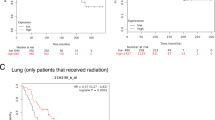Abstract
Antiangiogenic therapies are promising approaches to cancer control, but the details of their effects on subsequent tumor progression are not fully understood. Such therapies have the potential to eventually generate extensive amounts of tumor ischemia, and we previously demonstrated that ischemic conditions induce K-ras mutations in cells with deficient mismatch repair (MMR) mechanisms. This suggested that similar effects on oncogene mutagenesis may accompany antiangiogenic therapy. To test this, MMR-deficient colorectal cancer cells (Dks-8) were xenografted into immune-deficient mice and treated with the antiangiogenic regimen of low-dose/metronomic cyclophosphamide for 2 weeks followed by a 2-week recovery period without therapy. This treatment resulted in transient tumor growth inhibition, increased hypoxia, and decreased microvessel density, and cancer cells from treated tumors acquired activating mutations of the K-ras oncogene (K-rasG13D). In vitro exposure of Dks-8 cells to the active metabolite of cyclophosphamide (4-hydroxycyclophosphamide) had no effect on the K-ras status, indicating that there was no direct action of this alkylating agent on K-ras mutagenesis. In addition, cells sorted from hypoxic regions of Dks-8 tumors were enriched in K-rasG13D mutants. Collectively, our studies suggest that increases in tumor hypoxia induced by antiangiogenic treatment may lead to K-ras mutation and consequently tumor progression, especially in susceptible individuals.
This is a preview of subscription content, access via your institution
Access options
Subscribe to this journal
Receive 50 print issues and online access
$259.00 per year
only $5.18 per issue
Buy this article
- Purchase on Springer Link
- Instant access to full article PDF
Prices may be subject to local taxes which are calculated during checkout





Similar content being viewed by others
References
Aarnio M, Sankila R, Pukkala E, Salovaara R, Aaltonen LA, De la Chapelle A et al. (1999). Cancer risk in mutation carriers of DNA-mismatch-repair genes. Int J Cancer 81: 214–218.
Bernhard EJ, Stanbridge EJ, Gupta S, Gupta AK, Soto D, Bakanauskas VJ et al. (2000). Direct evidence for the contribution of activated N-ras and K-ras oncogenes to increased intrinsic radiation resistance in human tumor cell lines. Cancer Res 60: 6597–6600.
Bos JL . (1989). ras oncogenes in human cancer: a review. Cancer Res 49: 4682–4689.
Boyer JC, Umar A, Risinger JI, Lipford JR, Kane M, Yin S et al. (1995). Microsatellite instability, mismatch repair deficiency, and genetic defects in human cancer cell lines. Cancer Res 55: 6063–6070.
Browder T, Butterfield CE, Kräling BM, Shi B, Marshall B, O'Reilly MS et al. (2000). Antiangiogenic scheduling of chemotherapy improves efficacy against experimental drug-resistant cancer. Cancer Res 60: 1878–1886.
Brown JM . (2000). Hypoxic cytotoxic agents: a new approach to cancer chemotherapy. Drug Resist Updat 3: 7–13.
Brown JM, Wilson WR . (2004). Exploiting tumour hypoxia in cancer treatment. Nat Rev Cancer 4: 437–447.
Chang TKH, Weber GF, Crespi CL, Waxman DJ . (1993). Differential activation of cyclophosphamide and ifosfamide by cytochromes P-450 2B and 3A in human liver microsomes. Cancer Res 53: 5629–5637.
Chen J, Shinkai Y, Young F, Alt FW . (1994). Probing immune functions in RAG-deficient mice. Curr Opin Immunol 6: 313–319.
DeLisser HM, Christofidou-Solomidou M, Strieter RM, Burdick MD, Robinson CS, Wexler RS et al. (1997). Involvement of endothelial PECAM-1/CD31 in angiogenesis. Am J Pathol 151: 671–677.
Dexter DL, Spremulli EN, Fligiel Z, Barbosa JA, Vogel R, VanVoorhees A et al. (1981). Heterogeneity of cancer cells from a single human colon carcinoma. Am J Med 1: 949–956.
Emmenegger U, Morton GC, Francia G, Shaked Y, Franco M, Weinerman A et al. (2006). Low-dose metronomic daily cyclophosphamide and weekly tirapazamine: a well-tolerated combination regimen with enhanced efficacy that exploits tumor hypoxia. Cancer Res 66: 1664–1674.
Esteller M, Levine R, Baylin SB, Ellenson LH, Herman JG . (1998). MLH1 promoter hypermethylation is associated with the microsatellite instability phenotype in sporadic endometrial carcinomas. Oncogene 17: 2413–2417.
Folkman J . (1990). What is the evidence that tumors are angiogenesis dependent? J Natl Cancer Inst 82: 4–6.
Franco M, Man S, Chen L, Emmenegger U, Shaked Y, Cheung AM et al. (2006). Targeted anti-vascular endothelial growth factor receptor-2 therapy leads to short-term and long-term impairment of vascular function and increase in tumor hypoxia. Cancer Res 66: 3639–3648.
Galmarini CM, Galmarini FC . (2003). Multidrug resistance in cancer therapy: role of the microenvironment. Curr Opin Investig Drugs 4: 1416–1421.
Gasparini G, Longo R, Toi M, Ferrara N . (2005). Angiogenic inhibitors: a new therapeutic strategy in oncology. Nat Clin Pract Oncol 2: 562–577.
Halvarsson B, Lindblom A, Rambech E, Lagerstedt K, Nilbert M . (2004). Microsatellite instability analysis and/or immunostaining for the diagnosis of hereditary nonpolyposis colorectal cancer? Virchows Arch 444: 135–141.
Herman TS, Teicher BA, Holden SA, Collins LS . (1989). Interaction of hyperthermia and radiation in murine cells: hypoxia and acidosis in vitro, tumor subpopulations in vivo. Cancer Res 49: 3338–3343.
Hurwitz H, Fehrenbacher L, Novotny W, Cartwright T, Hainsworth J, Heim W et al. (2004). Bevacizumab plus irinotecan, fluorouracil, and leucovorin for metastatic colorectal cancer. N Engl J Med 350: 2335–2342.
Jain RK . (2005). Normalization of tumor vasculature: an emerging concept in antiangiogenic therapy. Science 307: 58–62.
Janssen HL, Haustermans KM, Balm AJ, Begg AC . (2005). Hypoxia in head and neck cancer: how much, how important? Head Neck 27: 622–638.
Jiricny J . (1998). Replication errors: cha(lle)nging the genome. EMBO J 17: 6427–6436.
Jubb AM, Oates AJ, Holden S, Koeppen H . (2006). Predicting benefit from anti-angiogenic agents in malignancy. Nat Rev Cancer 6: 626–635.
Kane MF, Loda M, Gaida GM, Lipman J, Mishra R, Goldman H et al. (1997). Methylation of the hMLH1 promoter correlates with lack of expression of hMLH1 in sporadic colon tumors and mismatch repair-defective human tumor cell lines. Cancer Res 57: 808–811.
Kerbel R, Folkman J . (2002). Clinical translation of angiogenesis inhibitors. Nat Rev Cancer 2: 727–739.
Kerbel RS, Yu J, Tran J, Man S, Viloria-Petit A, Klement G et al. (2001). Possible mechanisms of acquired resistance to anti-angiogenic drugs: implications for the use of combination therapy approaches. Cancer Metastasis Rev 20: 79–86.
Kerbel RS . (2006). Antiangiogenic therapy: a universal chemosensitization strategy for cancer? Science 312: 1287–1295.
Klement G, Baruchel S, Rak J, Man S, Clark K, Hicklin DJ et al. (2000). Continuous low-dose therapy with vinblastine and VEGF receptor-2 antibody induces sustained tumor regression without overt toxicity. J Clin Invest 105: R15–R24.
Koukourakis MI, Giatromanolaki A, Sivridis E, Fezoulidis I . (2000). Cancer vascularization: implications in radiotherapy? Int J Radiat Oncol Biol Phys 48: 545–553.
Liotta LA, Kleinerman J, Saidel GM . (1974). Quantitative relationships of intravascular tumor cells, tumor vessels, and pulmonary metastases following tumor implantation. Cancer Res 34: 997–1004.
Miller KD, Chap LI, Holmes FA, Cobleigh MA, Marcom PK, Fehrenbacher L et al. (2005a). Randomized phase III trial of capecitabine compared with bevacizumab plus capecitabine in patients with previously treated metastatic breast cancer. J Clin Oncol 23: 792–799.
Miller KD, Trigo JM, Wheeler C, Barge A, Rowbottom J, Sledge G et al. (2005b). A multicenter phase II trial of ZD6474, a vascular endothelial growth factor receptor-2 and epidermal growth factor receptor tyrosine kinase inhibitor, in patients with previously treated metastatic breast cancer. Clin Cancer Res 11: 3369–3376.
Minamoto T, Ougolkov AV, Mai M . (2002). Detection of oncogenes in the diagnosis of cancers with active oncogenic signaling. Expert Rev Mol Diagn 2: 565–575.
Mitchell RJ, Farrington SM, Dunlop MG, Campbell H . (2002). Mismatch repair genes hMLH1 and hMSH2 and colorectal cancer: a HuGE review. Am J Epidemiol 156: 885–902.
Motzer RJ, Bukowski RM . (2006). Targeted therapy for metastatic renal cell carcinoma. J Clin Oncol 24: 5601–5608.
Peltomaki P, Vasen H . (2004). Mutations associated with HNPCC predisposition—update of ICG-HNPCC/INSiGHT mutation database. Dis Markers 20: 269–276.
Perona R, Sánchez-Pérez I . (2004). Control of oncogenesis and cancer therapy resistance. Br J Cancer 90: 573–577.
Rak J, Coomber B, Yu JL . (2006). Oncogenes and tumor suppressor genes in therapeutic resistance: the role of evolving interrelationship between cancer cells and their host tissues. In: Tiecher B (ed). Cancer Drug Discovery and Development: Cancer Drug Resistance. Humana Press Inc.: NJ, USA, pp 67–103.
Rak J, Filmus J, Kerbel RS . (1996). Reciprocal paracrine interactions between tumour cells and endothelial cells: the ‘angiogenesis progression’ hypothesis. Eur J Cancer 32A: 2438–2450.
Rak J, Mitsuhashi Y, Bayko L, Filmus J, Shirasawa S, Sasazuki T et al. (1995). Mutant ras oncogenes upregulate VEGF/VPF expression: implications for induction and inhibition of tumor angiogenesis. Cancer Res 55: 4575–4580.
Ren S, Yang JS, Kalhorn TF, Slattery JT . (1997). Oxidation of cyclophosphamide to 4-hydroxycyclophosphamide and deschloroethylcyclophosphamide in human liver microsomes. Cancer Res 57: 4229–4235.
Rofstad EK, Galappathi K, Mathiesen B, Ruud EB . (2007). Fluctuating and diffusion-limited hypoxia in hypoxia-induced metastasis. Clin Cancer Res 13: 1971–1978.
Shahrzad S, Quayle L, Stone C, Plumb C, Shirasawa S, Rak JW et al. (2005). Ischemia-induced K-ras mutations in human colorectal cancer cells: role of microenvironmental regulation of MSH2 expression. Cancer Res 65: 8134–8141.
Shirasawa S, Furuse M, Yokoyama N, Sasazuki T . (1993). Altered growth of human colon cancer cell lines disrupted at activated Ki-ras. Science 260: 85–88.
Srivastava A, Laidler P, Davies RP, Horgan K, Hughes LE . (1988). The prognostic significance of tumor vascularity in intermediate-thickness (0.76–4.0 mm thick) skin melanoma. A quantitative histologic study. Am J Pathol 133: 419–423.
Takamizawa A, Matsumoto S, Iwata T, Tochino Y, Katagiri K, Yamaguchi K . (1975). Studies on cyclophosphamide metabolites and their related compounds. 2. Preparation of an active species of cyclophosphamide and related compounds. J Med Chem 18: 376–383.
Toyooka S, Tsukuda K, Ouchida M, Tanino M, Inaki Y, Kobayashi K . (2003). Detection of codon 61 point mutations of the K-ras gene in lung and colorectal cancers by enriched PCR. Oncol Rep 10: 1455–1459.
Varker KA, Biber JE, Kefauver C, Jensen R, Lehman A, Young D et al. (2007). Randomized phase 2 trial of bevacizumab with or without daily low-dose interferon alfa-2b in metastatic malignant melanoma. Ann Surg Oncol 14: 2367–2376.
Weidner N, Semple JP, Welch WR, Folkman J . (1991). Tumor angiogenesis and metastasis—correlation in invasive breast carcinoma. N Engl J Med 324: 1–8.
Yang JC, Haworth L, Sherry RM, Hwu P, Schwartzentruber DJ, Topalian SL et al. (2003). A randomized trial of bevacizumab, an anti-vascular endothelial growth factor antibody, for metastatic renal cancer. N Engl J Med 349: 427–434.
Yu JL, Rak JW, Carmeliet P, Nagy A, Kerbel RS, Coomber BL . (2001). Heterogeneous vascular dependence of tumor cell populations. Am J Pathol 158: 1325–1334.
Yu JL, Rak JW, Coomber BL, Hicklin DJ, Kerbel RS . (2002). Effect of p53 status on tumor response to antiangiogenic therapy. Science 295: 1526–1528.
Yu L, Waxman J . (1996). Role of cytochrome P450 in oxaza phosphorine metabolism. Deactivation via N-dechloroethylation and activation via 4-hydroxylation catalyzed by distinct subsets of rat liver cytochromes P450. Drug Metab Dispos 24: 1254–1262.
Yuan J, Glazer PM . (1998). Mutagenesis induced by the tumor microenvironment. Mutat Res 400: 439–446.
Zon G, Ludeman SM, Brandt JA, Boyd VL, Ozkan G, Egan W et al. (1984). NMR spectroscopic studies of intermediary metabolites of cyclophosphamide. A comprehensive kinetic analysis of the interconversion of cis- and trans-4-hydroxycyclophosphamide with aldophosphamide, and the concomitant partitioning of aldophosphamide between irreversible fragmentation and reversible conjugation pathways. J Med Chem 27: 466–485.
Acknowledgements
We thank Courtney Stone and Kanwal Minhas for technical support, Barb Mitchell for mouse husbandry and the members of the Coomber laboratory for their valuable suggestions. This work was supported by Canadian Cancer Society (National Cancer Institute of Canada Grant no. 016117 to BL Coomber and JW Rak).
Author information
Authors and Affiliations
Corresponding author
Additional information
Supplementary Information accompanies the paper on the Oncogene website (http://www.nature.com/onc).
Rights and permissions
About this article
Cite this article
Shahrzad, S., Shirasawa, S., Sasazuki, T. et al. Low-dose metronomic cyclophosphamide treatment mediates ischemia-dependent K-ras mutation in colorectal carcinoma xenografts. Oncogene 27, 3729–3738 (2008). https://doi.org/10.1038/sj.onc.1211031
Received:
Revised:
Accepted:
Published:
Issue Date:
DOI: https://doi.org/10.1038/sj.onc.1211031



